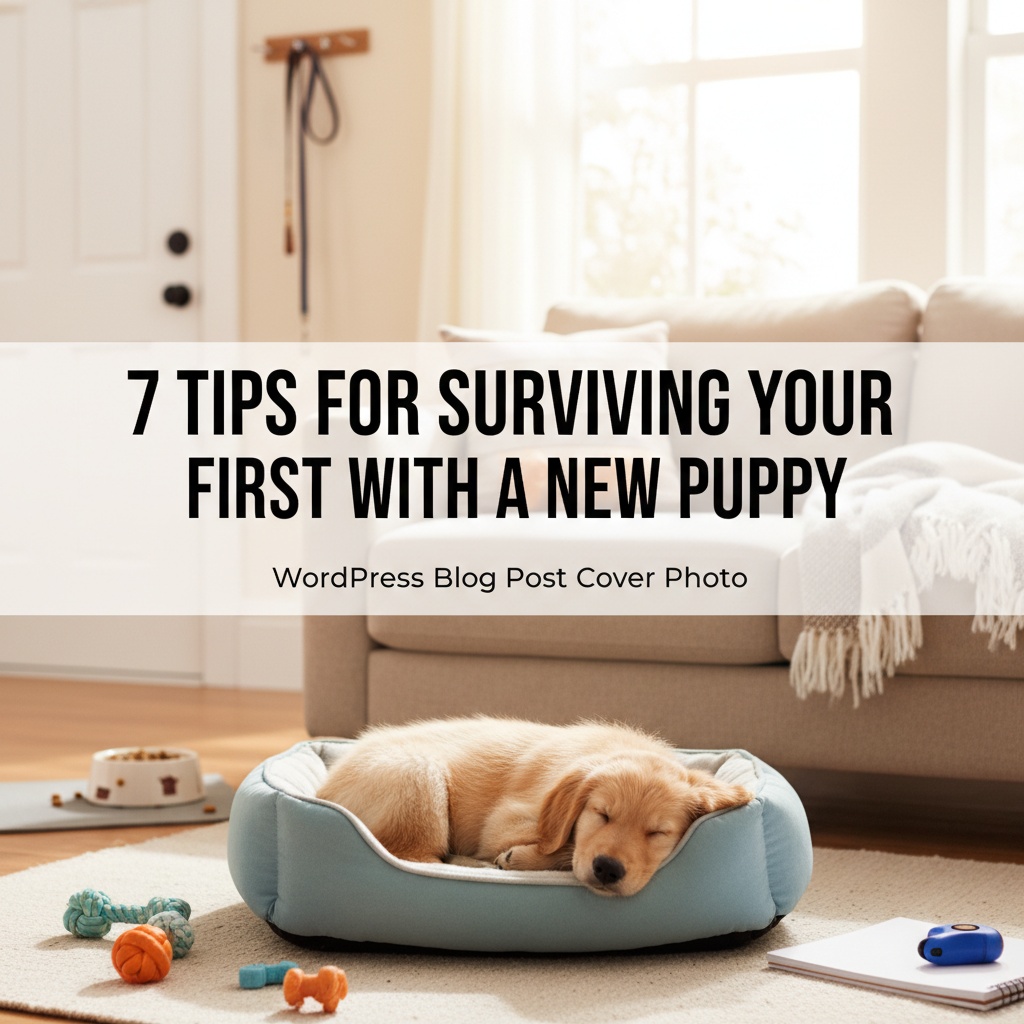7 Tips For Surviving The First Week With Your New Puppy
Estimated reading time: 5 minutes
- Supervision: Never leave your puppy unsupervised outside their safe zone or crate to avoid accidents and ensure safety (KH Pet, 3 Lost Dogs).
- Positive Firsts: Encourage exploration at their own pace and use gentle handling to get them accustomed to touch and grooming (Rover).
- Patience is Key: The first week can be exhausting, but remember this foundational time is crucial for building trust and establishing good habits for years to come.
Table of Contents
- 1. Keep Your House Calm
- 2. Set a Routine
- 3. Start Potty Training Immediately
- 4. Puppy Proof Your Home
- 5. Introduce the Crate Gradually
- 6. Begin Basic Socialization, But Go Slow
- 7. Gather All Essential Supplies in Advance
- Key Takeaways
1. Keep Your House Calm
The moment you welcome your new puppy, the environment should radiate tranquility. A calm household is pivotal in helping your puppy adjust to their new surroundings. Limit excitement and foot traffic in the home during the initial days. This means fewer visitors and quieter interactions. Allow your puppy to explore and become familiar with their surroundings at their own pace. This gradual introduction helps reduce anxiety, fosters confidence, and enables them to adapt to the changes more comfortably (Puppy Leaks, 3 Lost Dogs).
2. Set a Routine
Establishing a consistent routine within the first week is crucial for your puppy’s development. Dogs thrive on predictability, and a set schedule for feeding, bathroom breaks, play, and sleep can significantly reduce uncertainty and stress. Implementing a routine can also be an excellent opportunity for training, as your puppy will soon learn when to expect meals, potty breaks, and playtime (Puppy Leaks, Rover). A structured routine is not only comforting for your pet but also creates an environment conducive to effective training.
3. Start Potty Training Immediately
One of the primary focuses in the first week should be potty training. Start right from day one by frequently taking your puppy outside to the designated potty area, especially after eating, playing, or waking up. Use positive reinforcement by praising your puppy when they successfully relieve themselves in the appropriate spot. Consistency and patience are vital components in this training process. Remember, accidents will happen, and when they do, stay calm. This stage sets the foundation for a lifetime of good bathroom habits (Puppy Leaks, KH Pet).
4. Puppy Proof Your Home
Before your puppy arrives home, ensure that you thoroughly puppy-proof your living space. This involves removing or securing anything that could pose a danger, such as electrical cords, small objects they could choke on, hazardous plants, and shoes. It’s wise to use baby gates or closed doors to restrict access to certain areas of your home. Set up a specific puppy-safe zone equipped with toys and blankets to create a safe space for play and exploration (KH Pet, 3 Lost Dogs). This additional layer of safety can help prevent unwanted accidents and ensure a secure environment for your curious new friend.
5. Introduce the Crate Gradually
Crate training can be a highly beneficial aspect of your puppy’s adjustment in the first week. Introduce the crate gradually, transforming it into a cozy and inviting place with comfortable bedding and toys. Avoid forcing your puppy to stay in the crate for extended periods initially; instead, allow them to explore it at their own pace, creating positive associations. Gradually incorporate the crate into their daily routine as a safe haven where they can relax and feel secure (Rover, YouTube). Using a blanket with familiar scents can also ease their transition into crate life.
6. Begin Basic Socialization, But Go Slow
Socialization is essential, but it should be approached with care during the first week. Focus on gently acclimating your puppy to the sights, sounds, and smells of their new home. Introduce them to family members and any other pets already in the household, always under supervision. It’s best to refrain from taking your puppy to public places or overwhelming them with many new faces until they are fully vaccinated and less stressed. The aim during this period is to help them settle into their new environment rather than to overwhelm them with social interactions (Puppy Leaks, Rover, 3 Lost Dogs).
7. Gather All Essential Supplies in Advance
Before you bring your new puppy home, it’s imperative to have all necessary supplies ready. This includes puppy food, bowls, a collar and leash, ID tags, bedding, crate, puppy-safe toys, cleaning supplies for accidents, grooming tools, and even calming aids like “heartbeat” toys. Being well-prepared helps reduce chaos during the transition period and ensures your puppy’s needs are met right from the start (KH Pet). Having everything in place allows you to focus more on bonding and training rather than scrambling to gather essentials.
Key Takeaways
By following these seven tips, the initial adjustment period can be significantly smoother, setting a positive tone for your relationship with your new puppy. You’ll foster trust and cultivate good habits that will last a lifetime. Whether you’re an experienced pet owner or a first-time puppy parent, patience, understanding, and preparation go a long way in ensuring a successful and fulfilling journey with your new best friend.
FAQ Section
What should I do if my puppy has accidents indoors?
Stay calm and clean the mess without punishing your puppy. Reinforce outdoor potty breaks and be consistent with his schedule.
How can I help my puppy adjust to the crate?
Make the crate inviting with comfortable bedding and toys; introduce it gradually without forcing your puppy to stay inside for long periods initially.
When can I start taking my puppy outside for socialization?
Once your puppy is fully vaccinated, you can begin taking them to new environments while keeping the experience positive.
